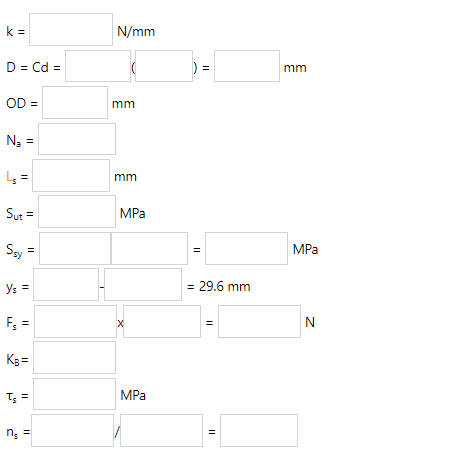Question 2 A helical compression spring is to be made of oil-tempered wire of 4-mm diameter with a spring index of C=10. The spring is to operate inside a hole, so buckling is not a problem and the ends can be left plain. The free length of the spring should be 80 mm. A force of 50N should deflect the spring 15 mm. 1. Determine the spring rate. 2. Determine the minimum hole diameter for the spring to operate in. 3. Determine the total number of coils needed.
Question 2 A helical compression spring is to be made of oil-tempered wire of 4-mm diameter with a spring index of C=10. The spring is to operate inside a hole, so buckling is not a problem and the ends can be left plain. The free length of the spring should be 80 mm. A force of 50N should deflect the spring 15 mm. 1. Determine the spring rate. 2. Determine the minimum hole diameter for the spring to operate in. 3. Determine the total number of coils needed.
Mechanics of Materials (MindTap Course List)
9th Edition
ISBN:9781337093347
Author:Barry J. Goodno, James M. Gere
Publisher:Barry J. Goodno, James M. Gere
Chapter2: Axially Loaded Members
Section: Chapter Questions
Problem 2.5.31P
Related questions
Question
Kindy answer correctly. Please show the necessary steps (the template is provided)

Transcribed Image Text:Question 2
A helical compression spring is to be made of oil-tempered wire of 4-mm diameter with a spring index of C=10. The
spring is to operate inside a hole, so buckling is not a problem and the ends can be left plain. The free length of the
spring should be 80 mm. A force of 50 N should deflect the spring 15 mm.
1. Determine the spring rate.
2. Determine the minimum hole diameter for the spring to operate in.
3. Determine the total number of coils needed.
4. Determine the solid length.
5. Determine a static factor of safety based on the yielding of the spring if it is compressed to its solid length.

Transcribed Image Text:k =
N/mm
D = Cd =
mm
OD =
mm
N3 =
mm
Sut =
MPa
Ssy =
Say
MPa
Ys =
= 29.6 mm
F; =
N
Kg =
T; =
MPa
n; =
II
Expert Solution
This question has been solved!
Explore an expertly crafted, step-by-step solution for a thorough understanding of key concepts.
This is a popular solution!
Trending now
This is a popular solution!
Step by step
Solved in 4 steps

Knowledge Booster
Learn more about
Need a deep-dive on the concept behind this application? Look no further. Learn more about this topic, mechanical-engineering and related others by exploring similar questions and additional content below.Recommended textbooks for you

Mechanics of Materials (MindTap Course List)
Mechanical Engineering
ISBN:
9781337093347
Author:
Barry J. Goodno, James M. Gere
Publisher:
Cengage Learning

Mechanics of Materials (MindTap Course List)
Mechanical Engineering
ISBN:
9781337093347
Author:
Barry J. Goodno, James M. Gere
Publisher:
Cengage Learning